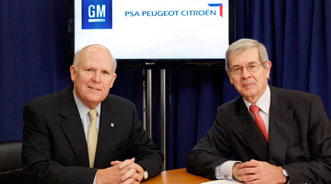GM-Peugeot Alliance Sets 2016 Target for Shared-Platform Model

General Motors and PSA Peugeot Citroën said Wednesday the companies have come together for an alliance that creates a global purchasing joint venture and also provides for the automakers to share vehicle platforms, components and modules.
GM and Peugeot plan on introducing their debut common-platform model by 2016, officials noted.
The alliance also sets a framework by which the companies can take advantage of other collaboration opportunities that may arise.
“This partnership brings tremendous opportunity for our two companies,” stated Dan Akerson, GM chairman and chief executive officer. “The alliance synergies, in addition to our independent plans, position GM for long-term sustainable profitability in Europe.”
Philippe Varin, chairman of the managing board of PSA Peugeot Citroën, added: “This alliance is a tremendously exciting moment for both groups and this partnership is rich in its development potential.
“With the strong support of our historical shareholder and the arrival of a new and prestigious shareholder, the whole group is mobilized to reap the full benefit of this agreement,” Varin continued.
In conjunction with the announcement, Peugeot also revealed a capital increase through which the automaker believes it can generate about 1 billion euros. This move will include preferential subscription rights for the automaker’s shareholders.
The capital increase is underwritten by a syndicate of banks. The Peugeot Family Group has invested in it “as a sign of its confidence in the success of the alliance.”
Additionally, per the agreement, GM intends to purchase a 7-percent equity stake in the French automaker, which would give it the second-highest ownership share.
Sharing of Platforms, More
Sharing more details about the partnership, the carmakers aim for the sharing of platforms/modules/components to help them save money and gain efficiencies, while also leveraging volumes and advanced technologies. Additionally, the automakers hope the sharing will lead to reduced emissions.
"Sharing of platforms not only enables global applications, it also permits both companies to execute Europe-specific programs with scale and in a cost-effective manner," officials contend.
The initial plan is to build small and midsize cars, MPVs and crossovers. They may also delve into low-emission vehicles.
Purchasing Cooperation
Explaining more about this element to the alliance, the companies say the global purchasing organization can be utilized for buying commodities, components and services.
This gives them the opportunity to take “full advantage of the join expertise, volume, platforms and standardized parts.”
Additional Opportunities, Details
Outside of these “two main pillars” described above, integrated logistics and transportation are among the other avenues being considered for collaboration in the alliance. As such, GM plans to work with Gefco — a PSA Peugeot Citroën subsidiary that focuses on integrated logistics — in a collaborative effort in which Gefco would be GM’s logistics provider in Europe and Russia.
Sharing some more elements of the alliance, officials estimated that by about five years down the road, the deal will likely be bringing in roughly $2 billion in annual synergies.
“The synergies will largely coincide with new-vehicle programs, with limited benefit expected in the first two years. It is expected the synergies will be shared about evenly between the two companies,” they noted.
Overseeing the alliance is a global steering committee comprised of senior leaders from the automakers. Each company will have an equal number on the committee.
To implement the alliance, the companies will have to get the regulatory green light in certain jurisdictions. They will also have to notify the applicable workers councils before moving forward.
The companies also emphasized that the “alliance enhances but does not replace either company’s ongoing independent efforts to return their European operations to sustainable profitability.”


